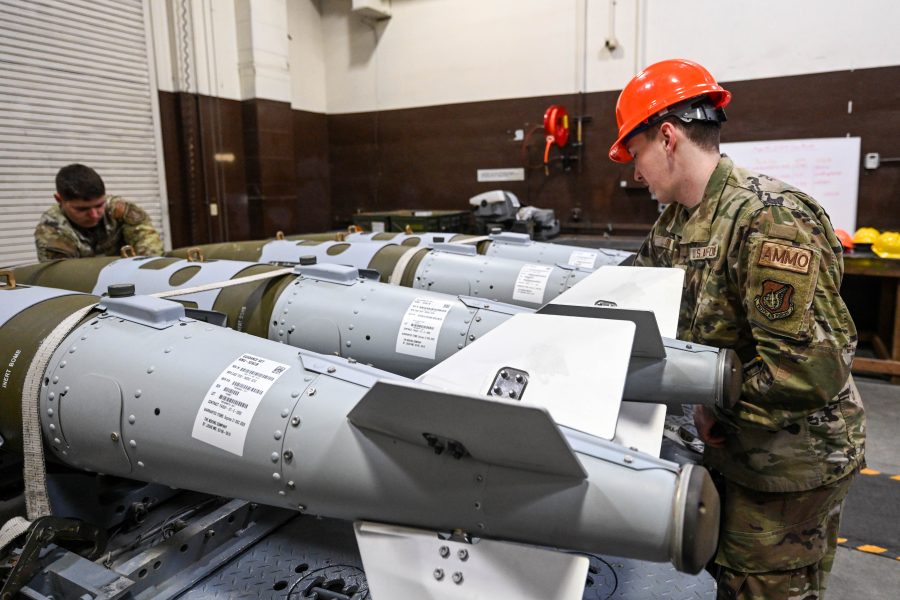When lawmakers and outside experts turn their attention to how the U.S. military can use of artificial intelligence, they tend to focus on weapons systems—the most consequential and risk-laden use cases—and on generative AI.
But behind the scenes, the Air Force is already using machine learning algorithms to help solve complex logistical problems—like how to store the munitions critical to projecting airpower.
The Automated Master Storage Planning, or A-MSP, app, was developed and beta-tested under a Small Business Innovation Research contract and is now being rolled out to munitions teams across Air Force Global Strike Command. Virtualitics, the contractor that developed it, claims the app has already saved “more than 50,000 man-hours, reduced human error, and accelerated decision-making.”
The app helps munitions teams plan the layout of the warehouses and other facilities where weapons are stored. That task can be challenging, for instance, when a large number of incoming assets have to be accommodated and the team needs to free up space.
“What they need to do is optimize their storage area, to ensure its contents are organized as efficiently as possible,” Justin Shehane, solutions leader for Virtualitics, told Air & Space Forces Magazine.
But, as Shehane knows from 20 years experience as an Air Force maintainer, figuring out how to organize items in storage when those items are highly explosive is not a simple matter; there are complex safety limitations and variables that have to be taken into account.
“Not all munitions can be stored next to one another,” explains Shehane, who retired in 2022 as a senior master sergeant. “There are specific munitions that need to be kept a certain distance from one another, and there are some that do have to be stored together. So there are many, many governing guidelines and safety constraints that we absolutely have to adhere to.”
There are variables beyond safety too. If items might be needed in a hurry, they may have to be stored somewhere they can be accessed quickly. If space is limited, Airmen need to figure out the most efficient use possible.
Traditionally, munitions specialists would be leafing through manuals to check the rules and planning out the placement of crates and other items on graph paper, Shehane said.
With A-MSP, Virtualitics claims that planning process can be slashed from weeks to minutes. The app is being used for all types of conventional munitions, but not for Global Strike’s nuclear weapons, which are managed separately.
A-MSP can devise a “base configuration” plan, Shehane explained, “where a user would go in and set up the types of structures and the storage requirements that a specific base may have” and the AI will produce a plan for the most efficient and effective use of the available space. And it can identify the best way to assemble all the pieces required for particular munitions, when there are multiple potential sources for the required elements.
At the heart of the app, said Shehane, is a “very complex constraint solver, which allows us to adhere to those multiple safety constraints and those rules and those guidelines that govern what we’re trying to do.”
A-MSP is based in the cloud, he explained, but once the plan is produced, it can be downloaded to a tablet or other device. “Some of these munition storage locations don’t have great internet service, so [A-MSP enables them] to still take those outputs and be mobile with the plan in different types of environments.”
Critically, Shehane said, A-MSP is able to show how it reached its conclusions, a needed capability to build users’ trust in AI. “We’re able to deliver explainability for our models,” he said. The reluctance of Airmen to trust “black box” AI, where its decisions can’t be explained afterwards, has been widely noted. To be successful, Shehane said, AI “has to be something that’s easy to use, but also easy to understand.”
Virtualitics last month received a one-year sole-source renewal of the phase III SBIR award they won last year for the A-MSP app. The company declined to disclose the dollar value of last month’s award, but last year’s phase III SIBR was for $893,000, according to a government website.
A-MSP is not the first artificial intelligence-based tool the Air Force has used for logistics. Back in 2020, the service introduced the Predictive Analytics and Decision Assistant, or PANDA, to collect data on parts and help Airmen know when they should replace or work on them before they broke. So-called “predictive maintenance” can improve airfleet availability and reduce lifecycle costs, and PANDA, developed by C3 is currently the Air Force’s system of record for it.
The Department of the Air Force also uses several Oracle cloud applications for back office operations which are being updated with AI capabilities, the company said last month. These include an enterprise resource planning app to track costs and help improve productivity; an enterprise performance management app to leverage insights from data and and improve decision-making; and a human capital management app, to gain more detailed workforce insights and help improve the employee experience for Airmen and their families.


